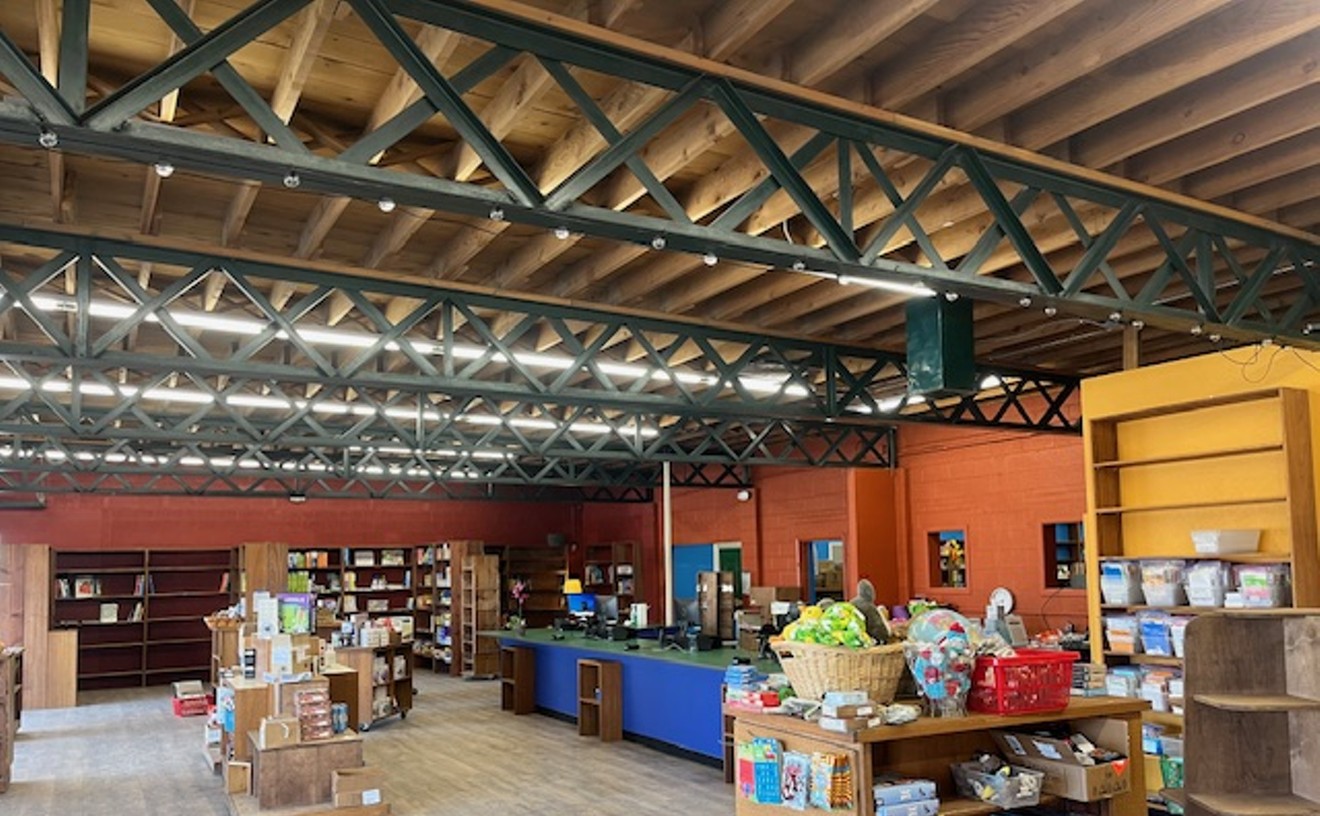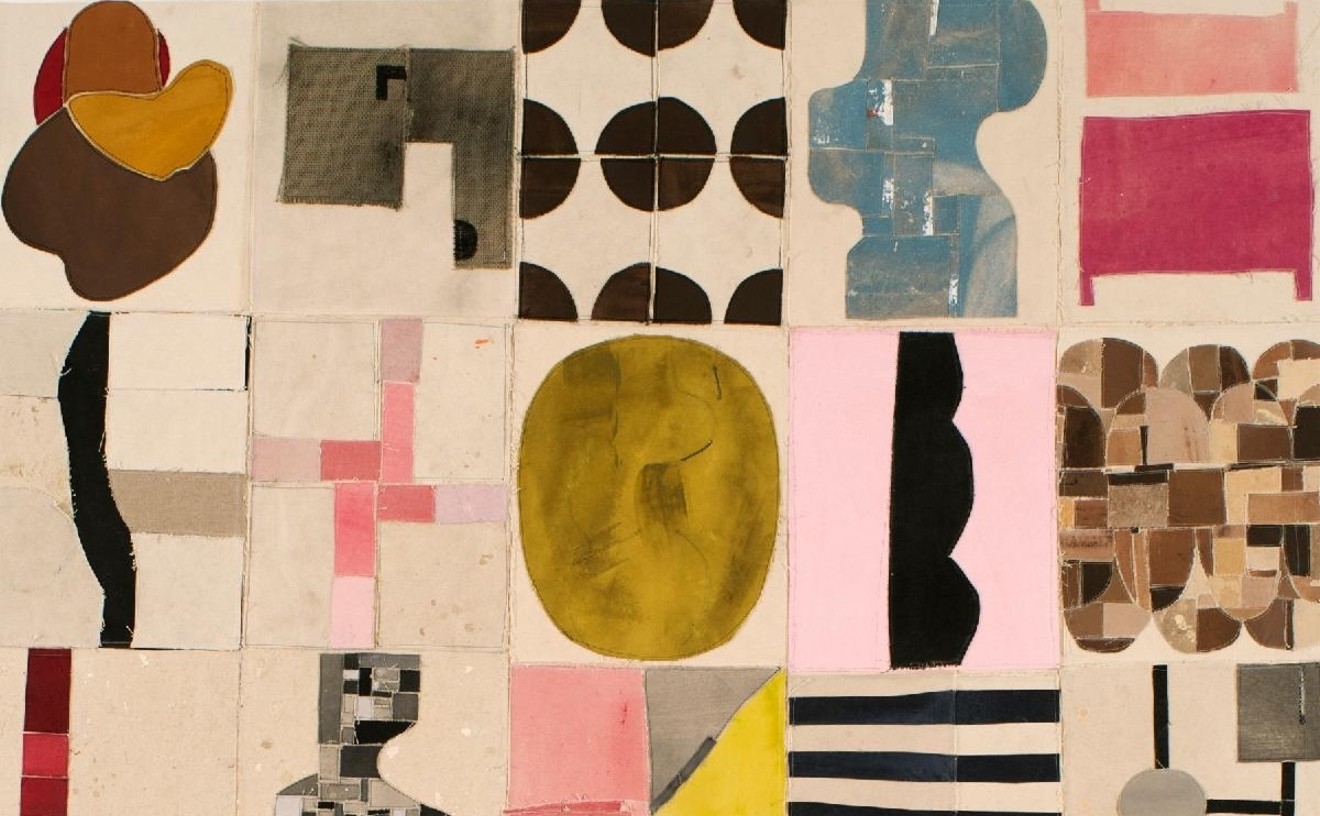Outdoor sculpture shows are mounted every year at the Denver Botanic Gardens, and it’s hard to imagine a better setting for artworks, especially in spring, when everything is budding out. The latest offering, Pixelated: Sculpture by Mike Whiting, comprises over a dozen of the artist’s signature boxy sculptures, and the hard edges of his forms contrast beautifully with the soft edges of the plantings in the gardens.
The exhibit was curated by Jen Tobias, associate director of exhibitions and art collections at the DBG. She chose pieces with a range of imagery, from objects to animals, birds to people; the selected works were loaned by Michael Whiting, Brigham Young University (his undergraduate alma mater) and the City of Denver. The resulting exhibit represents a brief survey of Whiting’s efforts over the past decade or so, with the oldest pieces dating from 2007 and the newest ones created this past year, specifically for this show. Regardless of when they were made or which series they belong to, though, all of the sculptures share certain attributes, and a pretty singular vision guides everything.
Whiting is interested in both conventionalizing and reducing his subjects by employing obsolete 8-bit digital technology used for early video games like Pac-Man to create his initial studies and then translate them into an overall style for his sculptures. By today’s standards, the pixels in those pioneering computer applications were huge. Taking them from the screen, Whiting creates building blocks to “construct” the outlines of the forms meant to convey his chosen subjects. He uses as few pixels as possible to sketch out the subject while still including enough to convey the specific illusion he wants. In the vocabulary of the pixels, stepped shapes stand in for natural curves, changing the contours of the outline. Whiting experiments quite a bit at this stage, creating variants in which elements are rendered slightly differently from one another.
The digital sketches are then translated into sculptures made from thick plates of steel that have been invisibly welded to form boxes. The outlines of these boxes are their chief defining feature and communicate what’s being depicted. Though the profiles of the boxes are sometimes elaborate, the four sides are invariably oriented at ninety-degree angles to one another so that every sculpture is basically an assemblage of quadrangles.
These boxy sculptures are superficially reminiscent of the classic minimalism of Donald Judd or Robert Morris, but Whiting violates the rules of minimalism by introducing recognizable subject matter, which was anathema to that movement, pushing his work into a post-minimal mode. Some years ago, Whiting addressed how his work was connected to minimalism by way of video games, noting that the form of his sculptures initially came out of Pac-Man, and only later from minimalism, because he was playing the game long before he became aware of the art. “Video gaming and minimalism arrived at the same visual conclusion through different means and by opposite intentions,” Whiting wrote.
Also veering from the strictures of minimalism is his handling of the surfaces: Instead of the expected uniformity, Whiting thinks of the flat sides of the sculptures as canvases, covering them with atmospheric abstract paintings. The dull, mottled surfaces are meant to evoke the sun-faded and scratched paint jobs of old pickup trucks, he explains, and he creates this desired effect in two ways: first, through the soft Easter egg shades he prefers, and second, by antiquing them after they’ve been painted. That’s when Whiting hits the surfaces with abrasives, including chains, so that they are scuffed up and mellowed out, the process erasing any remaining shine. The expressiveness of the painted surfaces contrasts with the precision of the steel-plate structures to which the paint has been applied. As I walked through the gardens with him, Whiting said that the way the finishes change as they weather outside was particularly appealing.
Among the oldest sculptures in the show, and one of my favorites, is 2007’s “Buck,” which depicts a male deer with an enormous antler rack, a clever arrangement of blocks that represent the antlers as two mirror halves and at the base also suggest the animal’s head. Whiting has made a pair of companion does; it’s a shame that they weren’t placed alongside “Buck” in the same grove of trees here.
“Pinkie” and “Mr. Green,” a smallish woman and man, date from the same period. The sculptures are carried out like thick digital stick figures; other than their different colors, the only distinguishing characteristics are the box on the back of the woman’s head suggesting a bun and two boxes on either side of her torso evoking the idea of a dress. These sculptures are installed on a concrete island in the middle of a water feature so that that they’re reflected in the pool’s surface, which produces a very neat effect. “Pinkie,” “Mr. Green” and “Buck” (along with one of the MIA “Doe” sculptures) are all from a sculptural group called “Walk in the Park,” a milestone in Whiting’s artistic development.
“Pinkie” and “Mr. Green” are both owned by the City of Denver and usually installed at the intersection of Walnut Street and Broadway. Until a few months ago, they were in a deplorable condition, covered with stickers and graffiti; they needed to be professionally cleaned by a conservator for this show. Although Whiting appreciates how his work changes through exposure to the elements, he’s not crazy about the unnatural forces of vandalism. So he must be totally bereft over the terrible state of “Rhino,” his most significant Denver commission, now almost hidden by spray paint. It stands on a tiny and grimy concrete island alongside Broadway, a terrible high-traffic spot and surely one of the worst possible locations for a sculpture — where it’s been installed right at grade, no less. As the city will need to move the piece for restoration, “Rhino” should be placed in a more appropriate location afterward, perhaps on top of a pedestal...at the zoo.
The first time I saw Whiting’s work, I was taken by how smart and good-looking his sculptures are (when not covered by graffiti, anyway). The only shortcoming of this show? There aren’t enough of his pieces, given the expanse of the gardens. I had the same complaint about last summer’s Calder show: Sometimes more is more.
Pixelated: Sculpture by Mike Whiting, through September 23, Denver Botanic Gardens, 1007 York Street, 720-865-3500, botanicgardens.org.
[
{
"name": "Air - MediumRectangle - Inline Content - Mobile Display Size",
"component": "12017618",
"insertPoint": "2",
"requiredCountToDisplay": "2"
},{
"name": "Editor Picks",
"component": "17242653",
"insertPoint": "4",
"requiredCountToDisplay": "1"
},{
"name": "Inline Links",
"component": "18838239",
"insertPoint": "8th",
"startingPoint": 8,
"requiredCountToDisplay": "7",
"maxInsertions": 25
},{
"name": "Air - MediumRectangle - Combo - Inline Content",
"component": "17261320",
"insertPoint": "8th",
"startingPoint": 8,
"requiredCountToDisplay": "7",
"maxInsertions": 25
},{
"name": "Inline Links",
"component": "18838239",
"insertPoint": "8th",
"startingPoint": 12,
"requiredCountToDisplay": "11",
"maxInsertions": 25
},{
"name": "Air - Leaderboard Tower - Combo - Inline Content",
"component": "17261321",
"insertPoint": "8th",
"startingPoint": 12,
"requiredCountToDisplay": "11",
"maxInsertions": 25
}
]














